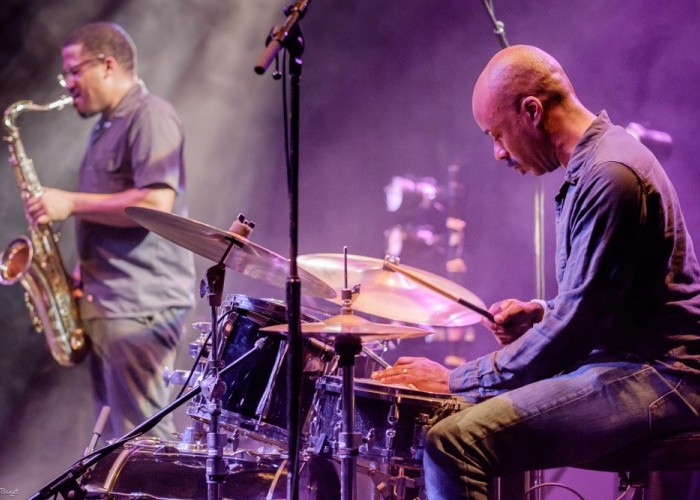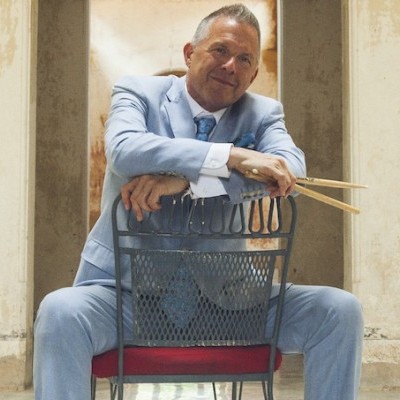Oct 28, 2025 10:47 AM
In Memoriam: Jack DeJohnette, 1942–2025
Jack DeJohnette, a bold and resourceful drummer and NEA Jazz Master who forged a unique vocabulary on the kit over his…

James Brandon Lewis has released his fifth album as a leader, Radiant Imprints, which pairs the saxophonist with drummer Chad Taylor.
(Photo: Laurent Poiget)Since moving to New York City in 2012, tenor saxophonist James Brandon Lewis has been creating quite a stir with his blustery tone and take-no-prisoners approach. Lewis, who leads his No Filter Trio and Unruly Notes, appears in a scintillating, conversational duo setting with drummer Chad Taylor on Radiant Imprints, his fifth album overall and the first for the Off-Record label.
Lewis’ 2010 debut as a leader, Moments, was recorded when he was studying at Cal Arts with Charlie Haden, Wadada Leo Smith and Joe LaBarbera. His follow-up on the OKeh label, 2014’s Divine Travels, came to fruition following a suggestion from pianist Matthew Shipp that the saxophonist and newly minted New York resident record with bassist William Parker and drummer Gerald Cleaver. His 2015 Days Of Freeman was a far funkier affair, featuring electric bass icon Jamaaladeen Tacuma, in-demand drummer Rudy Royston and producer High Priest (aka Hprizm), of Antipop Consortium fame. Back in January, Lewis also made a strong impression while performing with Harriet Tubman during the troupe’s 2018 Winter Jazzfest performance of Ornette Coleman’s Free Jazz.
The following has been edited for length and clarity.
How did you hook up with Chad Taylor?
I first played with Chad maybe three years ago at this place that no longer exists, which was called the Y Not Jazz Room. I had seen Chad play with [pianist] Cooper-Moore and a few other people that I know in the New York area, and I was just taken aback by his playing. Of course, his history of playing with Fred Anderson, Rob Mazurek and the whole Chicago scene is pretty awesome. So, I just feel honored that he and I could come together and make this duo project happen.
I’ve definitely grown a lot playing with him, because it’s very interactive. He’s not on autopilot, nor does he want to play with people who are on autopilot. It’s like, “Come on, react!” And it’s a beautiful conversation. It never goes to a place of just bashing or competing—but more of a healthy dialogue. So, I’m excited about the music, but also I’m excited about this new partnership-collaboration with Chad. It’s just going to get better with time.
There’ve been so many great sax-drums duo records.
John Coltrane and Rashied Ali, Charles Lloyd with Billy Higgins, Andrew Cyrille and Jimmy Lyons—the list goes on and on. But I definitely feel like we have a little to say and contribute to that rich legacy.
The thing about a duo, you’ve gotta be willing to fall flat on your face and get back up again. If you’re not willing to do that, it’s not going to work. That’s true improvisation … to be able to be OK with making the mistake. You gotta have some risk factor in there. That’s the thing that I’m learning.
There’s a YouTube clip from 2016 of you and Chad playing at the 6BC Gardens in the East Village. You open with “Imprints,” your take on John Coltrane’s “Impressions.” That piece and other Trane-inspired work appears on Radiant Imprints.
It’s funny because that concert that Chad and I did as part of the Gardens series happened two or three weeks after I played solo at a John Coltrane tribute concert in Philadelphia. It was a solo sax marathon with me, Sonny Fortune, Billy Harper, James Carter, Azar Lawerence, Greg Osby, Odean Pope and others to commemorate Trane’s 90th anniversary. For that concert, I worked out a lot of fragmentation of Trane’s music. “Imprints” is my take on “Impressions,” “Twenty Four” combines fragments of “Giant Steps” and “26-2,” “With Sorrow Lonnie” is based on “Lonnie’s Lament.” The whole inspiration for these pieces I developed was not wanting to go to that saxophone marathon concert and just play Trane tunes like how Trane would play it. There’s only one Trane. No one’s gonna do it better than Trane did it. So, you’re already up against Mount Everest when you try to get into that dance.
I wanted to do more of a nod than a regurgitation, so I came up with the idea of incorporating fragments of his tunes. To do a reinterpretation and fragment the melody was a very succinct decision to give a nod and then offer my own voice.
Talk about the profound influence that Coltrane’s music has had on your own playing.
I think just his willingness to take risks was so inspiring to me and so many other saxophone players. He was always searching and he was comfortable with who he was in his search. I checked out a lot of different things by him growing up, and I checked out a lot of his influences … different people he was involved with. No one can take away anything that he’s ever done. And there will never be another John Coltrane. To get caught up in chasin’ the Trane or trying to surpass him … it’s not about that. It’s about mapping his road and his progress and creating your own musical challenges and problems that are uniquely geared to what you are trying to work on.
You have a bold tone and a very powerful attack. But at the same time, on a tune like “Loved One,” you make use of space and dynamics throughout that piece.
That piece in particular has got a very kind of folk quality to it … maybe some Eastern influences in it. There’s many different timbres, many different ways to articulate a melody. And so that piece is a challenge for me to play, just because of my wanting to get the right interpretation of it. And I love that challenge. Every time I play it, I have to ask, “Did you play with enough space? Are those chords and the melody line really interacting with themselves?” It’s challenging. It’s a very beautiful piece and I feel like it’s one of my favorite pieces that I’ve ever penned.
The thing that I have realized about myself, and it certainly pertains to this tune, is I’m always going to be a tonal player. There’s a lot of motivic kind of development happening, so it isn’t completely random or atonal. Nor is it completely thought out. It’s somewhere in the middle. I practice, I try to spend a fair amount of time on the horn and I love melody. So, it’s been my habit over the last six years to build my solos off of the melody and do those kinds of fragments. And repetition is important in my playing in building stuff forward. Repetition builds tension, and so when you release it, it’s no different than talking.
Can you sum up your current musical direction?
I respect tradition, I’ve studied it, I’ve been to school, I’ve played with people that a lot of people respect and I’m just trying to say, “Hey, maybe you might think this is creative. We decided to do this and we’re offering it.”
I’m not trying to cure cancer, I’m not trying to be Trane and I’m not trying to be any of these people. I’m just trying to have a little offering, just a little voice, not a whole lot. I don’t want a whole lot, just a little bit, just a tiny bit. DB

Jack DeJohnette boasted a musical resume that was as long as it was fearsome.
Oct 28, 2025 10:47 AM
Jack DeJohnette, a bold and resourceful drummer and NEA Jazz Master who forged a unique vocabulary on the kit over his…

Always a sharp dresser, Farnsworth wears a pocket square given to him by trumpeter Art Farmer. “You need to look good if you want to hang around me,” Farmer told him.
Sep 23, 2025 11:12 AM
When he was 12 years old, the hard-swinging veteran drummer Joe Farnsworth had a fateful encounter with his idol Max…

D’Angelo achieved commercial and critical success experimenting with a fusion of jazz, funk, soul, R&B and hip-hop.
Oct 14, 2025 1:47 PM
D’Angelo, a Grammy-winning R&B and neo-soul singer, guitarist and pianist who exerted a profound influence on 21st…

Kandace Springs channeled Shirley Horn’s deliberate phrasing and sublime self-accompaniment during her set at this year’s Pittsburgh International Jazz Festival.
Sep 30, 2025 12:28 PM
Janis Burley, the Pittsburgh International Jazz Festival’s founder and artistic director, did not, as might be…

Jim McNeely’s singular body of work had a profound and lasting influence on many of today’s top jazz composers in the U.S. and in Europe.
Oct 7, 2025 3:40 PM
Pianist Jim McNeely, one of the most distinguished large ensemble jazz composers of his generation, died Sept. 26 at…